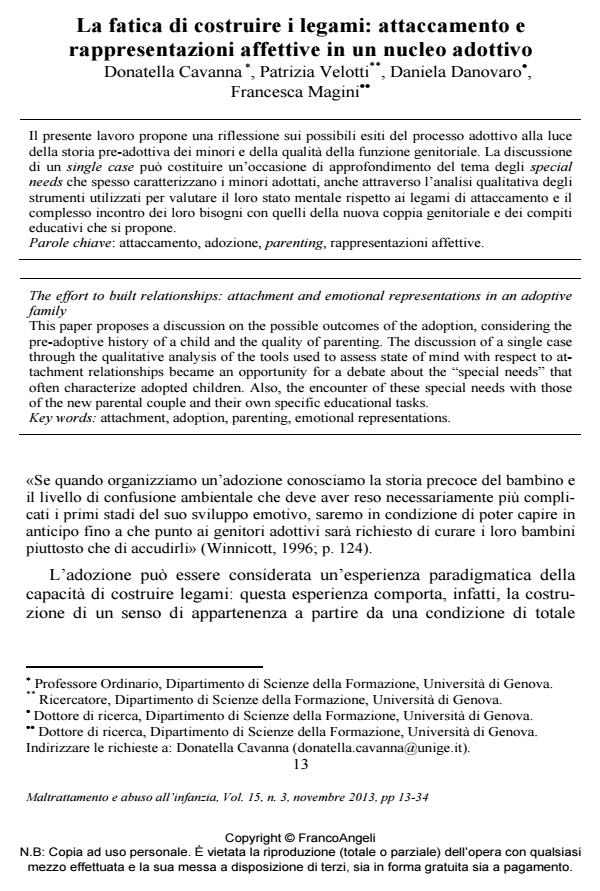The effort to built relationships: attachment and emotional representations in an adoptive family
Journal title MALTRATTAMENTO E ABUSO ALL’INFANZIA
Author/s Donatella Cavanna, Patrizia Velotti, Daniela Danovaro, Francesca Magini
Publishing Year 2013 Issue 2013/3
Language Italian Pages 22 P. 13-34 File size 687 KB
DOI 10.3280/MAL2013-003002
DOI is like a bar code for intellectual property: to have more infomation
click here
Below, you can see the article first page
If you want to buy this article in PDF format, you can do it, following the instructions to buy download credits

FrancoAngeli is member of Publishers International Linking Association, Inc (PILA), a not-for-profit association which run the CrossRef service enabling links to and from online scholarly content.
This paper proposes a discussion on the possible outcomes of the adoption, considering the pre-adoptive history of a child and the quality of parenting. The discussion of a single case through the qualitative analysis of the tools used to assess state of mind with respect to attachment relationships became an opportunity for a debate about the "special needs" that often characterize adopted children. Also, the encounter of these special needs with those of the new parental couple and their own specific educational tasks.
Keywords: Attachment, adoption, parenting, emotional representations.
- Disregolazione affettiva, disorganizzazione dell'attaccamento e disturbi alimentari: fattori di rischio individuali e familiari Valentina Guiducci, Fabiola Bizzi, Antonio Ferro, Donatella Cavanna, in MALTRATTAMENTO E ABUSO ALL'INFANZIA 2/2018 pp.65
DOI: 10.3280/MAL2018-002005 - Un'esperienza clinica di gruppo con genitori adottivi di bambini vittime di Esperienze Sfavorevoli Infantili Maria Gloria Gleijeses, Annamaria Scapicchio, in MALTRATTAMENTO E ABUSO ALL'INFANZIA 3/2018 pp.115
DOI: 10.3280/MAL2018-003007
Donatella Cavanna, Patrizia Velotti, Daniela Danovaro, Francesca Magini, La fatica di costruire i legami: attaccamento e rappresentazioni affettive in un nucleo adottivo in "MALTRATTAMENTO E ABUSO ALL’INFANZIA" 3/2013, pp 13-34, DOI: 10.3280/MAL2013-003002